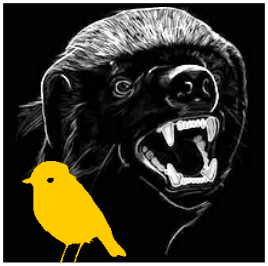The Indian peafowl has been attracted to cultivation for at least ten thousand years, long enough for humans inadvertently to have selected eyespots irrelevant for the sexual success of the male bird.

Prof. Mumblebard claims: “The Indian peafowl is an uncomplicated example of a wild species commensal with humans. The tail display has been sexually selected with no influence by humans, but in Indian traditions the species happens to be sacred and so it’s tolerated in settlements.”
Robin and the Honey Badger respond: “The Indian peafowl goes beyond commensal and deserves to be called ‘hortensic’ – a word we’ve coined for it. The many eyespots on the tail of the male Indian peafowl are the result of inadvertent selective breeding based on human aesthetic preferences. Indeed, it’s evident that the eyespots on the tail appeal to humans while largely eluding explanation in terms of protective mimicry or sexual selection. Protective mimicry falls short as an explanation because the usual function of eyespots is to startle would-be predators by suggesting the appearance of a new, unidentified predator. Presenting a jumble of eyespots would spoil this effect. And sexual selection isn’t a powerful explanation because eyespots should be no more attractive to peafowl than various other showy patterns would be. By contrast, a multiplicity of eyespots is appreciated by humans given their artistic capacity and particular perception of eye signals. Our alternative explanation could be tested by experiments to see which pattern is more attractive to females of the Indian peafowl: the eyespot pattern visible to the human eye or the ultraviolet pattern visible only to the bird.”

![]() “In other words”
“In other words”
Please join us here at the Bio-edge with your own comments. In the discussion below we encourage links to any evidence supporting either Prof. Mumblebard or Robin and the Honey Badger. Illustrations are welcome but please cite all sources or we may be forced under copyright to delete your comment.
***
Featured image: Male Indian peafowl (Pavo cristatus) performing courtship by Thimindu Goonatillake (CC BY-SA 2.0, Dancing Peacock)

